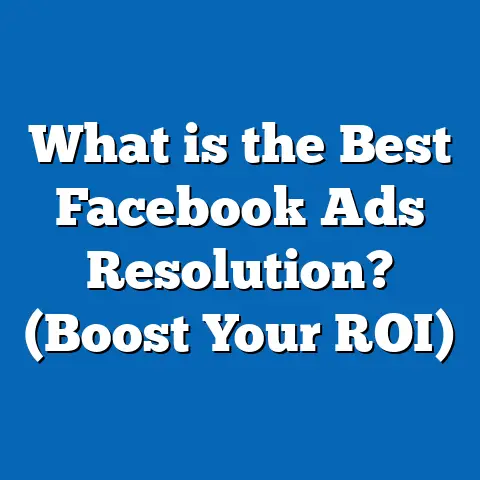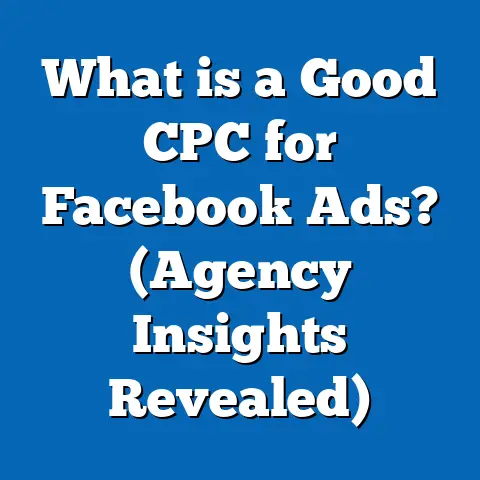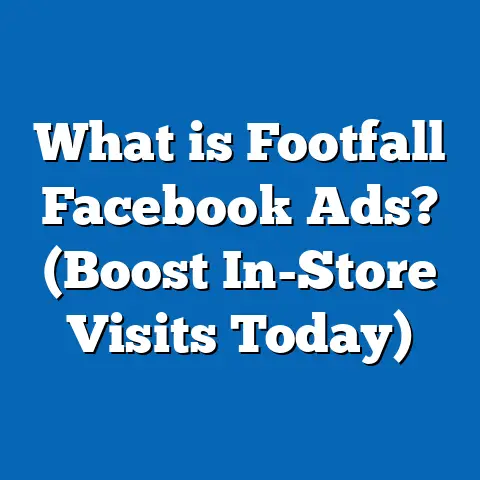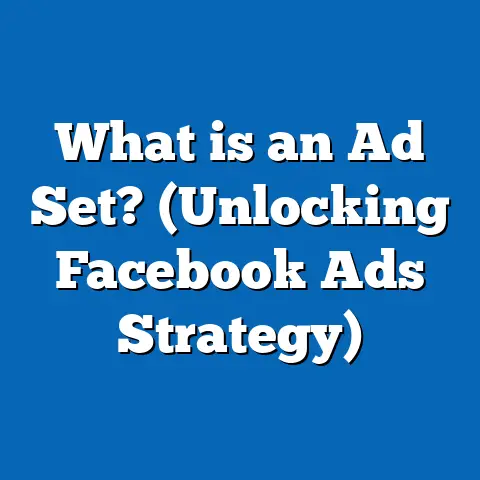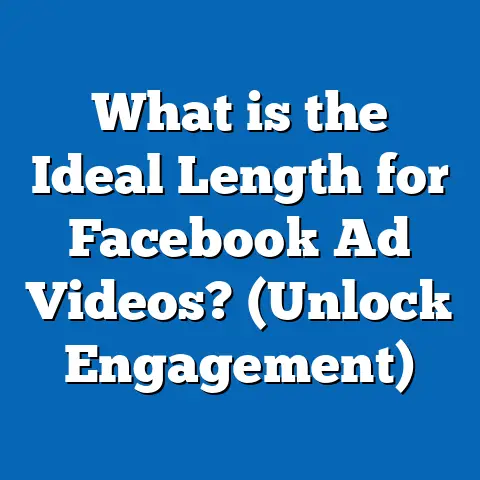What is Conversion Value in Facebook Ads? (Unlocking ROI Secrets)
What is Conversion Value in Facebook Ads? (Unlocking ROI Secrets)
Imagine spending hundreds, maybe thousands, on Facebook ads only to wonder if you’re truly making any profit. You see clicks, likes, and shares, but what about the actual return on investment (ROI)? This is where Conversion Value steps in — the key metric that reveals how much money your ads are bringing back to your business.
Table of Contents
- What is Conversion Value in Facebook Ads?
- Why Conversion Value Matters More Than Clicks or Impressions
- How Facebook Tracks Conversion Value: Technical Breakdown
- Setting Up Conversion Value Tracking Correctly
- Case Study: Real Business Impact of Tracking Conversion Value
- Conversion Value vs. Other Key Facebook Ad Metrics
- Practical Tips to Optimize Conversion Value and Maximize ROI
- Comparing Facebook’s Conversion Value Tracking with Other Platforms
- Advanced Strategies for Leveraging Conversion Value Data
- Common Mistakes to Avoid When Using Conversion Value Metrics
- Future Trends Affecting Conversion Value Tracking
- Conclusion: Key Takeaways and Next Steps
What is Conversion Value in Facebook Ads?
To understand conversion value, we first need to define a “conversion.” In Facebook advertising, a conversion is any action you want a user to take after interacting with your ad. This could be:
- Making a purchase
- Signing up for a newsletter
- Downloading an app
- Filling out a contact form
Conversion value is the monetary amount associated with these actions. For example, if someone buys a $100 product after clicking your ad, that $100 counts as conversion value. If another person signs up for a subscription worth $20 per month, the conversion value can be calculated based on the subscription’s lifetime value or initial payment.
Breaking Down Conversion Value
Conversion value isn’t just about individual purchases; it includes everything that adds financial worth to your business from your ads. This allows you to quantify:
- The revenue generated by campaigns
- The average value per conversion
- The total return on ad spend (ROAS)
This metric helps marketers focus on quality over quantity — not just how many conversions they get but how valuable those conversions are.
Why Measurement Accuracy Matters
Accurate conversion value tracking is vital because it directly influences budget decisions. Misreporting or lack of tracking can lead to:
- Overspending on ineffective campaigns
- Ignoring high-value customer segments
- Underestimating campaign profitability
Why Conversion Value Matters More Than Clicks or Impressions
Clicks and impressions are often the first metrics advertisers look at. While important, they don’t tell the entire story.
Understanding the Limitations of Clicks and Impressions
Clicks measure engagement but not revenue. A click without purchase or desired action has zero conversion value.
Impressions measure reach — how many times your ad was shown — but don’t guarantee engagement or conversions.
Data Insights That Prove the Point
According to WordStream’s 2023 report, businesses that track conversion value achieve an average of 20-30% higher ROI than those relying solely on clicks or impressions.
Facebook’s own data (2024) shows advertisers optimizing for conversion value saw up to a 40% increase in ad efficiency compared to those optimizing for link clicks.
Why Focus On Conversion Value?
Conversion value shifts your strategy from volume chasing to profitability focus.
Benefits include:
- Better Budget Allocation: Invest more where revenue returns are highest.
- Improved Campaign Optimization: Target audiences generating high-value conversions.
- More Accurate ROI Calculation: Understand actual financial impact rather than guesswork.
How Facebook Tracks Conversion Value: Technical Breakdown
Facebook uses several tools and methods to track conversion value across devices and channels.
Facebook Pixel
The pixel is a small piece of JavaScript code placed on your website pages. It tracks user actions like page views, add-to-cart events, purchases, etc., reporting them back to Facebook.
How Pixel Tracks Conversion Value
When a user completes a purchase, the pixel fires a “Purchase” event which includes a dynamic parameter called the value (the purchase amount). Facebook then attributes that revenue back to the ad exposure.
Facebook SDK (Software Development Kit)
For mobile apps, Facebook provides an SDK that developers integrate into apps. It tracks in-app events such as purchases, sign-ups, or level completions along with their associated values.
Conversions API (CAPI)
The Conversions API allows advertisers to send web events directly from their server to Facebook’s servers, improving tracking accuracy especially after browser privacy changes like iOS 14 updates.
Attribution Windows Explained
Facebook attributes conversion values based on user interaction within preset timeframes:
- 7-day click window: Conversions occurring within 7 days of a click are attributed.
- 1-day view window: Conversions within 1 day of viewing an ad (but not clicking) are attributed.
Advertisers can customize these windows depending on their sales cycle.
Setting Up Conversion Value Tracking Correctly
Accurate tracking starts with proper setup.
Step 1: Install Facebook Pixel or SDK
Make sure the pixel is installed on all relevant pages (especially checkout/thank you pages for e-commerce). For mobile apps, integrate the SDK properly.
Step 2: Define Standard or Custom Events
Facebook offers standard events like “Purchase,” “Lead,” “AddToCart,” but you can create custom events matching your business goals.
Step 3: Pass Dynamic Values with Events
When firing purchase events, pass the actual transaction amount dynamically via pixel parameters. For example:
fbq('track', 'Purchase', {
value: 99.99,
currency: 'USD'
});
This ensures Facebook receives precise revenue data tied to each conversion.
Step 4: Verify Event Data in Events Manager
Use Facebook’s Events Manager dashboard to test and confirm events are firing correctly with accurate values.
Step 5: Set Up Conversions API for Enhanced Accuracy
Due to browser restrictions on tracking cookies, integrating Conversions API helps maintain data consistency by sending server-side data alongside pixel data.
Case Study: Real Business Impact of Tracking Conversion Value
Company: Trendy Home Décor (E-commerce)
Industry: Online retail specializing in mid-range home furnishings
Initial Situation
Trendy Home Décor relied on link clicks and conversions but didn’t track monetary values tied to purchases. Their ad spend was $10,000 monthly with ROAS around 4.5x based on rough revenue estimates.
Implementation
They installed the Facebook pixel correctly on all checkout pages and passed dynamic purchase values for each transaction. They also set up Conversions API in parallel with pixel tracking.
Optimization Steps
- Analyzed conversion value data by campaign and audience segments.
- Created lookalike audiences based on high-value customers.
- Shifted ad budget toward campaigns generating above-average order values.
- Tested creatives emphasizing premium product bundles with higher ticket prices.
Results Over 3 Months
| Metric | Before Tracking | After Tracking |
|---|---|---|
| Monthly Ad Spend | $10,000 | $12,000 |
| Total Conversions | 1,500 | 1,400 |
| Total Conversion Value | $45,000 | $72,000 |
| ROAS (Return on Ad Spend) | 4.5x | 6x |
Although total conversions slightly decreased by about 7%, overall revenue grew by 60%, proving a shift toward quality rather than quantity.
Conversion Value vs. Other Key Facebook Ad Metrics
Understanding how conversion value fits into your overall analysis is essential.
| Metric | Meaning | Insight Provided | Limitations |
|---|---|---|---|
| Clicks | Number of clicks on your ad | Measures engagement | Doesn’t reflect profitability |
| Impressions | Times ad was shown | Measures reach | No indication of action taken |
| Conversions | Number of desired actions completed | Shows volume of user actions | Doesn’t show monetary impact |
| Cost Per Result | Average cost per conversion | Measures efficiency | Doesn’t account for value differences |
| Conversion Value | Total revenue generated from conversions | Shows monetary impact and ROI | Requires proper setup; can be misinterpreted without context |
Why Relying Solely on Conversions Can Mislead You
Many advertisers optimize campaigns based on sheer number of conversions or cost per result. However:
- Low-value conversions can inflate numbers but reduce profit margins.
- High-value purchases might be fewer but generate better ROI.
Conversion value offers a more complete picture by combining volume with financial impact.
Practical Tips to Optimize Conversion Value and Maximize ROI
Optimizing for conversion value involves data-driven strategy adjustments:
1. Use Value-Based Lookalike Audiences
Facebook allows you to create lookalike audiences based on customers who generated high conversion values rather than just any purchaser. This targets users more likely to spend more money.
2. Bid for Highest Value Actions
Switch from link click or conversion bidding to value optimization bidding in Facebook Ads Manager. This tells Facebook’s algorithm to prioritize users most likely to produce high-value conversions.
3. Segment Campaigns by Product Price Range
Separate campaigns for low-ticket versus high-ticket products help allocate budget effectively without diluting performance metrics across varied price points.
4. Test Creative Focused on High-Value Offers
Highlight premium products, bundles, or exclusive deals that encourage larger purchases instead of discounts that might attract bargain hunters with low order values.
5. Leverage Dynamic Product Ads (DPAs)
DPAs enable personalized retargeting by showing users products they’ve viewed or related items with prices visible upfront—boosting average order values.
6. Monitor Frequency Closely
High ad frequency can cause audience fatigue, reducing engagement and ultimately lowering conversion value. Rotate creatives often and cap frequency when needed.
7. Use Time-of-Day and Day-of-Week Optimization
Analyze when your high-value customers convert most often and schedule ads accordingly for better efficiency.
Comparing Facebook’s Conversion Value Tracking with Other Platforms
Each advertising platform has its own approach to tracking conversion value.
| Platform | Conversion Value Tracking Features | Unique Advantages |
|---|---|---|
| Facebook Ads | Pixel + SDK + Conversions API with dynamic value | Deep audience targeting & cross-device tracking |
| Google Ads | Conversion tracking via Google Tag Manager | Ties searches to revenue; strong intent signals |
| TikTok Ads | Pixel & Event API | Strong video engagement metrics |
| LinkedIn Ads | Insight Tag with conversion tracking | B2B targeting precision |
| Snapchat Ads | Pixel + Event API | Younger demographic reach |
What Makes Facebook Stand Out?
Facebook combines extensive user behavioral data with its powerful targeting engine and dynamic event tracking capabilities. This allows:
- Cross-device attribution (mobile + desktop)
- Multi-event tracking with dynamic values passed in real-time
- Sophisticated bidding based on predicted conversion values
Advanced Strategies for Leveraging Conversion Value Data
Marketers wanting to go beyond basics can apply advanced tactics:
Multi-Touch Attribution Modeling
Facebook Attribution tools can analyze how multiple touchpoints contribute to conversion value rather than just last-click attribution. This uncovers hidden drivers of high-value sales.
Predictive Analytics Using Machine Learning
Leverage machine learning models trained on historical conversion value data to predict future high-value customers and optimize targeting accordingly.
Incrementality Testing (Holdout Tests)
Use experimental designs where some users are excluded from seeing ads (holdout groups) to measure true incremental lift in conversion value driven by ads versus organic behavior.
Cross-Channel Integration
Combine Facebook conversion data with CRM systems and offline sales data using tools like Customer Data Platforms (CDPs) for a holistic view of customer lifetime value generated by ads.
Common Mistakes to Avoid When Using Conversion Value Metrics
Avoid these pitfalls that can distort your understanding of ROI:
- Not Passing Dynamic Values: Sending static or no values leads to underreporting revenue.
- Misconfigured Pixels: Missing purchase page pixels mean lost data.
- Ignoring Attribution Settings: Default windows may not match your sales cycle.
- Over-reliance on Last Click Attribution: This ignores earlier touchpoints that influenced purchase decisions.
- Mixing Currency Without Proper Settings: Can cause incorrect revenue calculation if you run multi-currency campaigns.
- Not Testing Pixel Setup Regularly: Facebook’s Events Manager provides testing tools—use them frequently.
- Failing To Use Conversions API: Browser privacy updates have reduced pixel effectiveness alone.
- Focusing Only On Short-Term Transactions: Consider lifetime value for subscriptions or repeat buyers too.
Future Trends Affecting Conversion Value Tracking
The digital advertising landscape is evolving rapidly with privacy regulations and technology changes impacting tracking methods:
Privacy Regulations & Cookie Restrictions
New privacy laws (like GDPR) and browser policies (Safari’s Intelligent Tracking Prevention) limit cookie tracking reliability, making server-side tracking via Conversions API essential.
AI-Powered Optimization Enhancements
Facebook continues improving its AI algorithms that use conversion value data for smarter bidding and audience targeting — expect greater automation and predictive capabilities ahead.
Enhanced Offline & Omnichannel Attribution
Integration between online digital ads and offline sales will become smoother through improved data syncing tools, helping brands capture full customer journey conversion values.
Conclusion: Key Takeaways and Next Steps
Conversion value is the cornerstone metric for understanding the true financial impact of Facebook ads. Proper setup and optimization allow marketers and business owners to go beyond vanity metrics and focus on profitability.
Key Takeaways:
- Conversion value measures actual revenue generated from your ads—not just clicks or conversions.
- Accurate pixel and event setup is essential for reliable data.
- Optimizing campaigns for high-value conversions improves ROAS significantly.
- Advanced tactics like multi-touch attribution and incrementality testing deepen insights.
- Privacy trends require adopting newer tracking technologies like Conversions API.
- Use conversion value data strategically to refine audiences, creatives, bids, and budgets.
Next Steps:
- Audit your current pixel and event setups for accuracy.
- Implement dynamic value passing on all relevant events.
- Enable Conversions API alongside pixel tracking.
- Switch campaign objectives towards value optimization bidding.
- Analyze campaign reports focusing on revenue impact.
- Experiment with lookalike audiences based on high-value customers.
- Continuously test creatives promoting premium offers.
- Integrate offline sales data if applicable for full funnel insights.
Unlocking the secrets of conversion value will help you drive smarter decisions and unlock higher returns from your Facebook advertising efforts.

